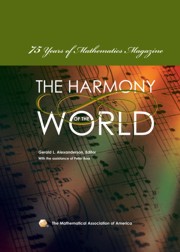Book contents
- Frontmatter
- Introduction
- Contents
- A Brief History of Mathematics Magazine
- Part I The First Fifteen Years
- Part II The 1940s
- Part III The 1950s
- Part IV The 1960s
- Part V The 1970s
- Trigonometric Identities
- A Property of 70
- Hamilton's Discovery of Quaternions
- Geometric Extremum Problems
- Pólya's Enumeration Theorem by Example
- Logic from A to G
- Tiling the Plane with Congruent Pentagons
- Unstable Polyhedral Structures
- Part VI The 1980s
- Briefly Noted
- The Problem Section
- Index
- About the Editors
A Property of 70
from Part V - The 1970s
- Frontmatter
- Introduction
- Contents
- A Brief History of Mathematics Magazine
- Part I The First Fifteen Years
- Part II The 1940s
- Part III The 1950s
- Part IV The 1960s
- Part V The 1970s
- Trigonometric Identities
- A Property of 70
- Hamilton's Discovery of Quaternions
- Geometric Extremum Problems
- Pólya's Enumeration Theorem by Example
- Logic from A to G
- Tiling the Plane with Congruent Pentagons
- Unstable Polyhedral Structures
- Part VI The 1980s
- Briefly Noted
- The Problem Section
- Index
- About the Editors
Summary
Editors' Note: Paul Erdős is perhaps the best known of 20th century research mathematicians. Stories about his illustrious but unusual career, his uniqueway of doingmathematics, and his eccentricities abound. Since his death in 1996 two biographies of him have appeared—Paul Hoffman's The Man Who Loved Only Numbers (Hyperion, 1998) and Bruce Schechter's My Brain Is Open (Simon and Schuster, 1998). Further, an MAA film about him, “N Is a Number”, has been widely distributed and shown on public television. He held only one regular academic appointment during his long life—he died at the age of 83—so he was able to travel continually to visit other mathematicians and to share with them news of outstanding problems. Extraordinarily prolific, he wrote, at last count, 1514 papers, very often with collaborators, mainly in number theory, combinatorics and graph theory. Because he had collaborators in so many countries, someone wrote the following limerick:
A problem both deep and profound
Is whether a circle is round.
In a paper by Erdős,
Written in Kurdish,
A counterexample is found.
Here he finds an extension of a well-known theorem in number theory that says that 30 is the largest integer such that all smaller positive integers relatively prime to it are themselves primes.
It is well known (see, e.g., [3]) that 30 is the largest integer with the property that all smaller integers relatively prime to it are primes.
- Type
- Chapter
- Information
- Harmony of the World75 Years of Mathematics Magazine, pp. 139 - 142Publisher: Mathematical Association of AmericaPrint publication year: 2007

